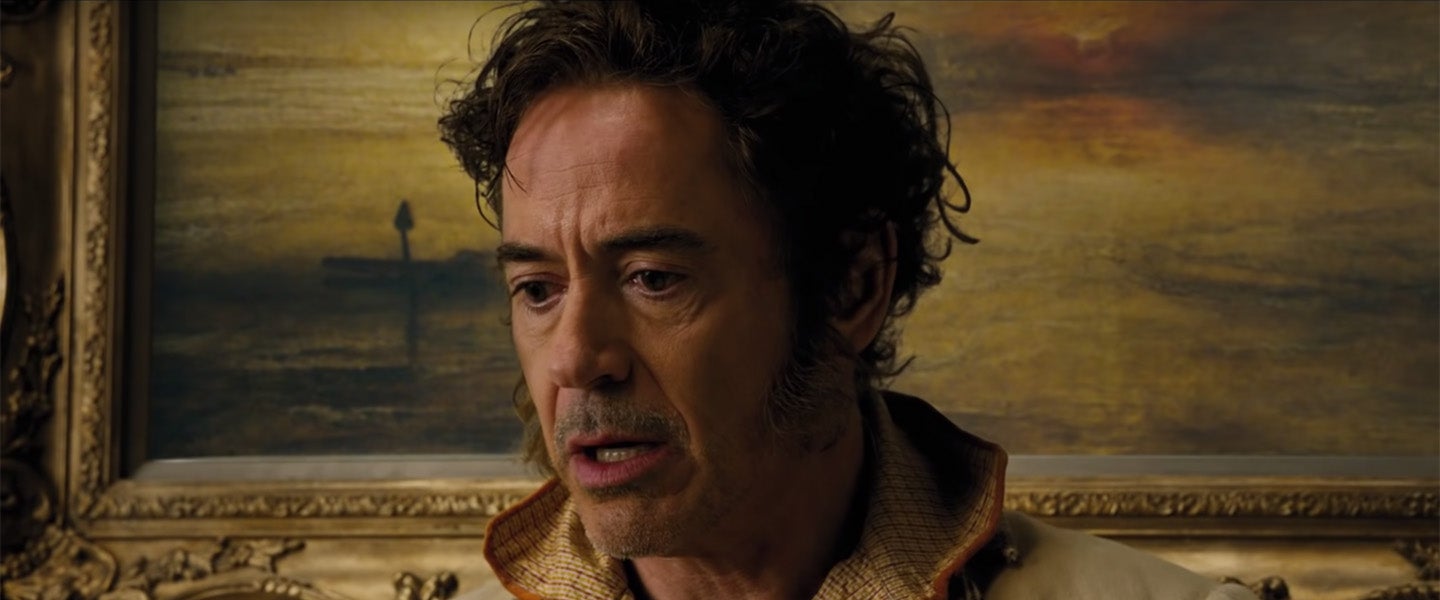Hugh Lofting’s 1920 novel The Story of Doctor Dolittle: Being the History of His Peculiar Life at Home and Astonishing Adventures in Foreign Parts Never Before Printed doesn’t waste many words explaining its hero. Within a few paragraphs, readers learn that Dr. John Dolittle lived many years ago in “a little town called Puddleby-on-the-Marsh”; that he’s generally regarded as “clever”; that he likes wearing a high hat; and that dogs and children tended to follow him wherever he went. Subsequently, we learn he’s terrible with money, lives with his sister and generally prefers animals to people to the point that his many pets drive away his human patients. He also, fairly easily, learns how to talk to animals, mostly through a little nudging from his parrot Polynesia and by paying attention when most others don’t.
That’s more or less all we learn about Dolittle, and it’s enough to carry him through nine subsequent novels that take him far and wide — even, at one point, to the moon — and find him talking to all sorts of animals, including a dog detective. Nonetheless, Dolittle, the latest adaptation of Lofting’s stories, supplies a tragic backstory for the good doctor involving a wife whose death at sea has turned him into a grumpy, bearded recluse.
Directed and co-written by Steven Gaghan (the writer of Traffic and writer/director of Syriana), Dolittle opens with a colorful animated sequence that follows Dolittle (Robert Downey Jr.) and Mrs. Dolittle as they cheerfully travel the world rescuing and befriending animals. The biggest problem with the movie: That opening proves far more appealing than the CGI-filled headache that follows, which focuses on the now-dour Dolittle’s attempts to overcome his traumatic past and save Queen Victoria (Jessie Buckley) from being poisoned by a villainous duo played by Michael Sheen and Jim Broadbent.
Still, there is a practical reason to go this route. Children’s books are no easier to adapt than books for adults, since simplicity is often part of their charm. Lofting’s novels mostly glide from one amusing incident to another, an approach that doesn’t really work for feature films, which need different shapes and rhythms. Beyond this, to ask Downey to play a one-dimensional character, no matter how winsome, is to risk wasting a great actor. That Dolittle chooses to flesh out Dolittle’s character isn’t really a problem in itself: Rather, it’s the cheap, familiar way it does so. (Coupled, it must be said, with a puzzlingly charmless performance by Downey, who speaks in a bizarre, vaguely Welsh accent.) Either way, grafting on a tragic backstory has become the de rigueur to add heft and bulk to a story that may not always benefit from it.
Ron Howard and Jim Carrey may not be to blame for this habit, but they didn’t help. Working from a script by Jeffrey Price and Peter S. Seaman, their 2000 live-action adaptation of Dr. Seuss’ How the Grinch Stole Christmas has the unenviable task of stretching a story perfectly suited for the length of a bedtime story or a TV special to fill a feature-length film. Their solution: lots of Jim Carrey shtick, jokes sure to fly over the heads of young viewers, and, yes, a tragic backstory. The film reveals that the Grinch doesn’t irrationally hate Christmas: He hates it because of a traumatic childhood incident involving puppy love, bullying and a misguided attempt to shave off his beard. Not to be outdone, the animated 2018 film The Grinch gave the green guy an entirely different tragic backstory.
In the years between Grinches, that kind of blanks-filling had become almost obligatory. In Roald Dahl’s novel Charlie and the Chocolate Factory, merrily sadistic chocolatier Willy Wonka’s past remains undiscussed. It also doesn’t seem to need discussing for the story to work. Ditto for the much-loved (but deeply creepy) 1971 film Willy Wonka & the Chocolate Factory. Tim Burton’s 2005 adaptation, however, gives Wonka an estranged, repressive dentist father to explain his candy obsession.
Scripted by John August, the subplot plays at times like he and Burton couldn’t shake off the themes of Big Fish, released two years prior. Released in 2012, Wreck-It Ralph even makes a joke of the habit (and its application in video games as well as movies). “Jeepers, is she always like this?,” Fix-It Felix Jr. (Jack McBrayer) asks about Sergeant Tamora Jean Calhoun, the tough-as-nails, alien-battling soldier voiced by Jane Lynch. “It’s not her fault,” he’s told. “She’s programmed with the most tragic backstory ever.” (To be fair, she did lose the love of her life to bloodthirsty aliens on her wedding day.)
The grafted-on tragic backstory hasn’t just been a problem for kids’ films, either. In 2009, critic (and MEL contributor), Noel Murray published an essay called “Hey Screenwriters, Enough With the Backstory Rationing Already!” that addressed the irksome (and still existent) trend of parceling out nuggets of tragic backstory throughout a film to explain a cryptic character’s behavior. Most of these stories could be summed up, in Murray’s words, as “the usual ‘broken childhood’ bullshit.”
It’s worth unpacking that phrase a bit. The key words aren’t “broken childhood” but “usual” and “bullshit.” It’s not that a tragic backstory is never necessary — it’s that it’s often lazily attached to a character. Tragic backstories too often play like an easy way to give a character depth, even characters that don’t need it. Sometimes the more we know about a character, the less compelling they seem. Comics critic Scott McCloud’s observation that less-detailed drawings allow for a deeper connection with comics characters often applies to other forms as well. The biggest problem with Solo: A Star Wars Story, for instance, is that it reveals Han’s tragic past and, in the process, makes him a duller, less mysterious character.
Of course, some characters need tragic pasts. Batman’s not Batman without that unfortunate incident in Crime Alley: It’s the moment that made him and informs everything he does. The same can be said for characters as diverse as The Bride in Kill Bill and Lee Chandler, the grief-stricken loner played by Casey Affleck in Manchester by the Sea. Their losses define them, and they’re essential to stories that invite reflection about loss. Put another way: If your character’s tragic backstory doesn’t feel as essential as Batman’s, maybe it’s not essential at all.
All that said, there’s a reason filmmakers can’t let the habit go: Sometimes it works. Dreamworks’ charming 2008 film Kung Fu Panda spends much of its running time depicting the transformation of an out-of-shape, kung fu-loving panda named Po (Jack Black) into a disciplined, confident fighting machine. Kung Fu Panda 2, a 2011 sequel, goes the tragic backstory route. Fighting the forces of the villainous peacock Lord Shen (Gary Oldman), Po finds himself traumatized by newly stirred memories of his past, in which he was ripped from his parents at a tender age as part of Shen’s attempt to commit panda genocide. Dispensing flashes of remembered trauma out throughout the film as Po remembers more of his origins, it’s a textbook example of attempting to deepen a character by giving him an unspeakably sad past.
Yet it would take a heart of stone not to be moved by the way the film — directed by Jennifer Yuh Nelson from a script by Jonathan Robert Aibel and Glenn Todd Berger — lets it play out, in large part because the film becomes about Po’s need to get over his tragic past, to move on and not be defined by it. He learns to become, in other words, more than just a screenwriter’s cliché.
Maybe Dr. Dolittle should have talked to him before his latest movie.

